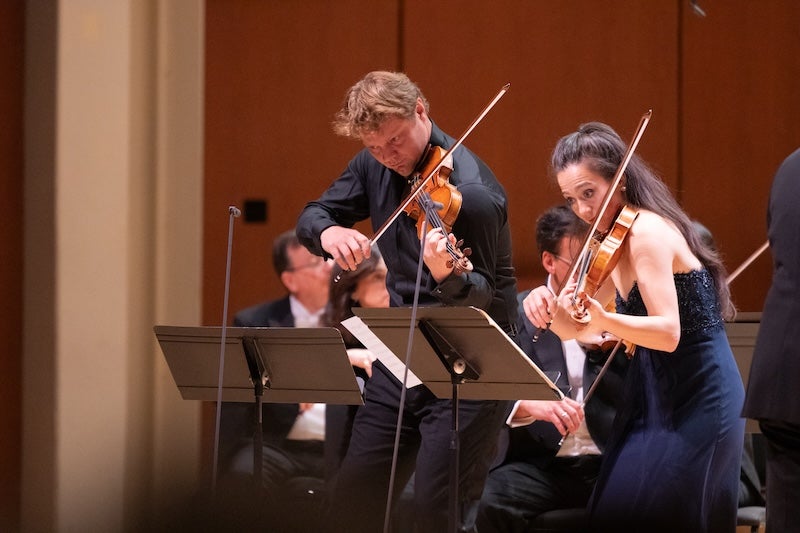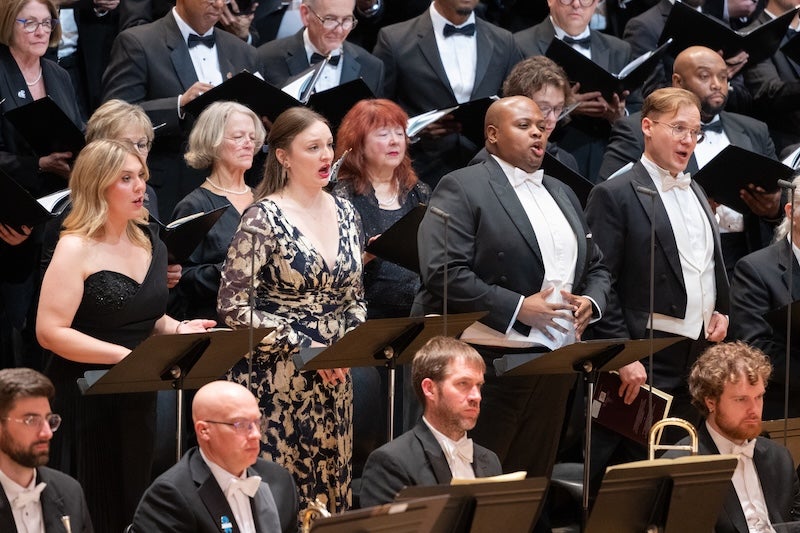Stutzmann puts an exclamation point on Beethoven Project
Concert Reflections with Jon Ross
In this series from local music journalist Jon Ross, he reflects on the ASO’s Delta Classics Series with fresh insights into each concert.

Photos by Rand Lines
NOV 14 | Does the Ninth always make for a monumental gathering?
In his book “The Symphony,” Michael Steinberg, who spent decades writing program notes for the San Francisco Symphony and the Minnesota Orchestra, noted that when programming turns to Beethoven’s final symphony, “a performance of it can never be an ordinary event, just another concert.”
That’s always felt true with the Atlanta Symphony and the ASO Chorus – the grandeur of the evening, the packed Symphony Hall audience, the thrill of witnessing something special. Music Director Nathalie Stutzmann even chose the Ninth for her debut with the ASO.
Thursday, Beethoven’s Ninth brought with it even more heightened importance as the summation of the ASO’s successful, season-spanning Beethoven Project. It additionally stood as the season premiere of the full ASO Chorus, an all-volunteer ensemble prepared as always with careful attention by Norman Mackenzie. Baritone Leon Košaviç, on hand for Stutzmann’s earlier performance of the Ninth, joined a trio of superb vocalists – soprano Christina Nilsson, mezzo-soprano Rhianna Cockrell and tenor Siyabonga Maqungo – for Beethoven, joined by the Chorus for the final symphonic movement.
But before Beethoven, there was Bach.
To begin the evening, concertmaster David Coucheron and assistant concertmaster Lauren Roth-Gómez engaged in a lively violin dialogue during Bach’s “Concerto in D minor for two violins and string orchestra.” (Two years ago, Stutzmann brought the concerto to the stage with Coucheron and Justin Bruns.) The double-violin concerto turned into an excellent study in how the audience reacts to performers. The entire ensemble seemed thrilled to play crisp, courtly passages of bubbly notes with vigor and enthusiasm. That joy reverberated throughout the hall, creating a truly noteworthy performance.

Baritone Košaviç then took the stage for another round of Bach: Cantata 56, “Ich will den Kreuzstab gerne tragen.” More than just an appetizer, these chamber ensemble Bach pieces really let the audience hear thrilling soloists in a more intimate setting. Košaviç – who, later in the program, would sing the first thrilling “Freude,” ushering the famous “Ode to Joy” ending of Beethoven’s Ninth – showcased a thundering low range. In parts, his voice took on a honeyed grain as he ascended to the top of his range.
Performed by the ASO for the first and only time by Robert Shaw in 1968, Bach’s Cantata marks the second time Stutzmann has presented a Bach cantata to Atlanta audiences in the last few weeks. As with the moving performance of Bach’s “Cantata 150” about a month ago, Thursday night required a stripped-down chamber ensemble and a grouping of the ASO Chamber Chorus. Košaviç’s voice shined throughout the piece but sounded especially bright and buoyant during the third movement, an aria supported by oboe, bassoon and organ.

Much has been written about tempos in regard to Atlanta performances of Beethoven’s Ninth. Yes, Stutzmann chooses a brisk pace for her Beethoven, but it’s not aggressively fast (and Atlanta audiences have certainly heard "aggressively fast”). It works well (I now hear slower interpretations as somewhat boring), and the chorus and orchestra responded to her vision on Thursday, creating a memorable performance. Certain impressions from the evening still ring out in my mind: trepidation in the strings during the opening bars, akin to standing on the edge of a lake, testing the water with your toe, anxious to dive in; the famous final melody, emerging as a tantalizing whisper in the low strings, subdued but focused; and of course, the powerful, full-throated roar of the ASO Chorus.

Beethoven’s Ninth is one of those pieces that inspires; it’s the only way to cap off a Beethoven study while being an exquisite showcase for the power of both the orchestra and the ASO Chorus. There are two more chances to catch the show: Saturday at 8 p.m. and Sunday at 3 p.m., which will also be livestreamed outdoors in Colony Square.